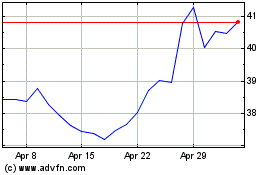Supreme Court Rejects Puerto Rico Debt-Restructuring Law
June 13 2016 - 1:00PM
Dow Jones News
WASHINGTON—The Supreme Court on Monday struck down Puerto Rico's
effort to restructure its public utility debts, ruling Congress had
precluded the territory from enacting its own bankruptcy
legislation.
The 5-to-2 vote increases pressure on Congress to act to resolve
the island territory's fiscal crisis, since Puerto Rico as a U.S.
territory has no authority to provide for municipal
bankruptcies.
Last week, the U.S. House passed bipartisan legislation to
create a debt-restructuring process for the territory, which would
be overseen by a seven-member federal board. No federal funds would
be spent to bailout the island. It awaits action in the Senate.
The Supreme Court's decision means the pending legislation in
Congress is really the only way to create a mechanism to avoid a
disorderly restructuring of Puerto Rico's debt.
Monday's case involved an effort by Puerto Rico to ease one
element of its pervasive fiscal crisis by restructuring the debt of
its public utilities. But the case highlighted the unusual status
the island holds within the U.S. federal structure, as an
"unincorporated territory" subject to federal control with neither
voting representation in Congress nor the quasi-sovereign powers of
the 50 states.
Congress excluded the territory from authorization it provided
U.S. municipalities to restructure their debts under section 9 of
the federal bankruptcy code. Puerto Rico interpreted its omission
as implicitly providing it with the authority to address the issue
on its own, and the territorial legislature enacted a law allowing
several public agencies and utilities to discharge most of their
debts despite creditors' objections.
Bondholders read the federal law in precisely the opposite way,
seeing it as providing Puerto Rico no authority to restructure debt
either through section 9 or its own statutes. Lower courts
agreed.
Bondholders in the case—Franklin Resources Inc. and Oppenheimer
Holdings Inc.—hold approximately $1.56 billion in bonds issued by
the Puerto Rico Electric Power Authority, a utility covered by the
challenged statute.
"The holders of Prepa bonds have the right to a receiver to
collect the pledged revenues, and the right to compel an increase
in electricity rates so that revenues will be sufficient to repay
the bonds," the Franklin Funds said in a court brief. Rather than
discharge the debt, it called for appointment of a receiver who
"can and will keep the lights on, and who also can increase
revenues, cut costs and collect debts."
Because Puerto Rico bonds are exempts from all state and federal
taxes, Franklin and other funds focused on a particular state's
municipal bonds have filled out their portfolios with Puerto Rico
bonds. The island is about $70 billion in debt and has missed bond
payments.
Justice Clarence Thomas wrote the majority opinion, joined by
Chief Justice John Roberts and Justices Anthony Kennedy, Stephen
Breyer and Elena Kagan.
Justice Sonia Sotomayor dissented, joined by Justice Ruth Bader
Ginsburg.
Justice Samuel Alito recused himself from the case. He gave no
explanation for sitting out the case, as is customary. But his
financial disclosures list numerous mutual funds managed by
Franklin and other companies, including funds focused on tax-free
income.
Last week, the Supreme Court underscored Puerto Rico's dependent
status in ruling that, for criminal prosecution purposes, the
territory is a division of the federal government and lacks an
independent source of sovereignty akin to that claimed by states
and Indian tribes.
The distinction is important for the Constitution's
double-jeopardy clause, which prevents the same "sovereign" from
repeatedly trying a defendant for the same offense, but allows
separate prosecutions by federal, state and tribal authorities.
Write to Jess Bravin at jess.bravin@wsj.com
(END) Dow Jones Newswires
June 13, 2016 12:45 ET (16:45 GMT)
Copyright (c) 2016 Dow Jones & Company, Inc.
Oppenheimer (NYSE:OPY)
Historical Stock Chart
From Jun 2024 to Jul 2024

Oppenheimer (NYSE:OPY)
Historical Stock Chart
From Jul 2023 to Jul 2024
